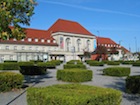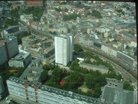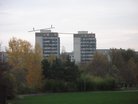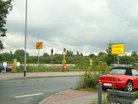Bachelor Urbanistik
Vorlesung: Instrumente und Verfahren der Stadt- und Regionalplanung
1. Fachsemester | Barbara Schönig | 2 SWS, 3 ECTS
Die Vorlesung bietet einen ersten strukturierten Überblick über Genese, gesellschaftliche Funktion, aktuelle Herausforderungen und institutionelle Organisation der Stadtplanung. Sie beinhaltet die Darstellung und Diskussion ausgewählter aktueller Themen der Stadtentwicklung und Stadtplanung, und führt so an das thematische Feld sowie das Aufgaben- und Kompetenzspektrum der Stadtplanung heran, das zukünftige Stadtplaner/innen erwartet. Anhand ausgewählter Beispiele und der Diskussion aktueller Herausforderungen von Stadtentwicklung werden die Besonderheiten planerischer Problemstellungen und die daraus resultierenden methodischen Herausforderungen an Stadtplanung als Disziplin herausgearbeitet.
Vorlesung: Allgemeines Bau- und Planungsrecht
3. Fachsemester | HonProf. Olaf Langlotz | 2 SWS, 3 ECTS
Die Vorlesung dient der Einführung in das Planungsrecht, insbesondere in das Recht der Bauleitplanung nach BauGB (Baugesetzbuch) und BauNVO (Baunutzungsverordnung).
Planungsprojekt: Kreaktiver Schulumbau – Planen mit Kindern

5.+7. Fachsemester, selbstbestimmtes Projekt | Steffen de Rudder (Städtebau) und Barbara Schönig (Stadtplanung) | 8 SWS, 12 ECTS
Gegenstand des Projekts ist die Entwicklung und Umsetzung eines Konzepts zur partizipativen Umgestaltung eines Schulstandorts und des zugehörigen Außengeländes im Kontext der städtischen Umgebung. Ziel ist es, durch dieses Projekt den bis 2018 anstehenden Um- und Ausbau der Gemeinschaftsschule Weimar (Standort An der Hart) gemeinsam mit den Kindern und Lehrer/innen der Schule vorzubereiten. Im Laufe des Wintersemesters sollen Bestandsanalysen gemacht werden, Bedarfe ermittelt werden und erste Konzepte entstehen sowie eine Projektwoche vorbereitet werden, in der die Konzepte weiterentwickelt werden und gemeinsam erste Maßnahmen umgesetzt werden. Gegenstand des Projekts sind sowohl die theoretische Auseinandersetzung mit Partizipation mit Kindern sowie die Auseinandersetzung mit planerischen sowie städtebaulichen und architektonischen Fragen der Schulstandortentwicklung und -gestaltung. Es ermöglicht darüber hinaus die eigenständige Organisation der Umsetzung eines solchen partizipativen Prozesses in enger Abstimmung mit den Betreuern sowie den Ansprechpartnern auf Seiten der Schule. Das Projekt ist integriert in das Programm „Kulturagenten für kreative Schulen“ und wird auf Fördergelder aus diesem Topf zur inhaltlichen Vorbereitung der Partizipationsprozesse und Umsetzung einzelner Maßnahmen zugreifen können.
Anmeldung mit einem kurzen Motivationsschreiben bis zum 15.09.2013 an barbara.schoenig[at]uni-weimar.de, steffen.derudder[at]uni-weimar.de
Projektsitzungen nach Vereinbarung.
Planungsprojekt: Jena: Wohnen in der wachsenden Stadt

1. Fachsemester | Achim Schröer | 8 SWS, 12 ECTS
Di. 10:00-16:00 Uhr | Beginn: 15.10.2013
Während in vielen Regionen Ostdeutschlands von Schrumpfung gesprochen wird, wächst die Bevölkerung in den Städten der Thüringer „Impulsregion“, in Erfurt, Weimar und Jena: Es wird dort knapp am Wohnungsmarkt. Gleichzeitig wird bundesweit von einer Reurbanisierung gesprochen und damit von einer Wiederentdeckung der Attraktivität (inner)städtischer Lebensformen. Im Planungsprojekt soll diese „neue Wohnungsfrage“ am Beispiel der Stadt Jena untersucht werden: Was sind die treibenden Kräfte und welche Herausforderungen bestehen am Jenaer Wohnungsmarkt? Was bedeutet dies stadträumlich, welche Typologien sind besonders interessant? Wie reagieren städtische Politik und Verwaltung, welche Instrumente und welche Akteure spielen dabei eine Rolle? Aufbauend auf einer Analyse sollen Lösungskonzepte entwickelt werden, die die ganze Bandbreite der Wohnungsfrage von institutionellen Fragen bis zum Städtebau integrieren.
Planungsprojekt: Weimar station, thank you for travelling with...

Bahnhöfe in Weimar (… und Los Angeles)
7. Fachsemester | Arvid Krüger | 8 SWS, 12 ECTS
Bahnhöfe sind innerhalb einer Stadtregion sind– im besten Sinne – Knotenpunkte eines stadtregionalen Mobilitätsnetzwerks. Als Eingang in die Stadt stellen sie zugleich eine Art Visitenkarte dar. Der Weimarer Bahnhof stellt sich in diesem Sinne zweifach als interessantes Beispiel dar: Einerseits wegen seiner städtebaulichen Ambivalenz: während der Weimarer Kulturbahnhof 2005 als Bahnhof des Jahres ausgezeichnet und der Bahnhofsvorplatz eine hochwertige urbane Eingangssituation darstellt findet sich auf der anderen Seite ein scheinbar vergessener Hinterhof, den man im Alltag nur (mit dem Auto) betritt, um bei einem der Supermärkte was zu kaufen. Hier findet sich sicherlich einer der relevantesten Räume für städtische Erweiterungen in der wachsenden Stadt Weimar. Andererseits aber erfährt der Bahnhof in den nächsten Jahren auch eine Transformation seiner Funktion im stadtregionalen Kontext, die einerseits Entwicklung entlang der Bahntrasse Erfurt – Weimar – Jena postuliert, andererseits aber die Weimar (neben Jena, Naumburg und Saalfeld) als Fernzughalte zugunsten des Hochgeschwindigkeits-Knotenpunkts in Erfurt abwertet. Welche Bedeutung spielt diese Entwicklungsachse für Weimar als Stadt und für das Bahnhofsumfeld als einem möglichen Entwicklungsbereich an dieser Achse? Welche Entwicklungsperspektiven bieten sich, wenn der Bahnhof Weimar von einem Fernverkehrshalt zu einer S-Bahn-Haltestelle funktional und symbolisch „degradiert“ wird?
Mit der ambivalenten stadträumlichen Situation und möglichen Perspektiven des Bahnhofsumfeldes unter den Bedingungen der stadtregionalen Transformationsprozesse und dem Wachstum Weimars wird sich dieses Projekt auseinandersetzen. Der Bahnhof und sein Umfeld sind dabei nicht Kern, sondern Ausgangspunkt für die Entwicklung konzeptioneller Ideen von der städtischen bis zur stadtregionalen Ebene („Impulsregion“ bzw. „Dreistadt“).
Gleichzeitig zum Projekt an der Bauhaus-Universität startet an der Price School of Public Policy im Studiengang Policy, Planning and Development an der University of Southern California in Los Angeles eine thematisch ähnlich ausgerichtete Lehrveranstaltung, die sich u.A. mit dem Ausbau des kalifornischen High-Speed-Rail-Networks und dem Ausbau des S-Bahn-Systems (Metrolink) beschäftig. Studierende aus beiden Lehrveranstaltungen gemeinsam können im Februar/März an einem gemeinsamen Planning Lab teilnehmen, in dessen Rahmen jeweils eine Woche an der Entwicklung von Planungskonzeptionen für Bahnhofsumfelder in Transformationsprozessen in Los Angeles bzw. Weimar gearbeitet wird. Die Planning Labs werden als Studierendenaustausch organisiert und können als separate Lehrveranstaltung im Wahlpflichtbereich belegt werden. An dem Austausch können bis zu 17 Studierende teilnehmen, die bevorzugt aus dem Studienprojekt gewählt werden. Es wird ein Joint Planning Lab beider Studierendengruppen geben.
Seminar: JOINT PLANNING LAB Weimar / Los Angeles: California / Thuringia – connected by rail development

Freier Wahlbereich | Barbara Schönig, Arvid Krüger | Blockveranstaltung, 3 ECTS
Urbanistik (Stadtplanung), Bauhaus-Universität and the Price School of Public Policy (Program Policy, Planning and Development, University of Southern California)
In California and Germany alike, high-speed-rail systems are being developed and under construc-tion. Whereas the Californian one between Sacramento/San Francisco and San Diego will be an almost completely new one, the Eastern North-South Axis between Baltic See/Berlin and Munich/Alpes runs as well on existing tracks as on completely new ones. The part through Thuringia will be a new one that will change the rail network within the state and also fundamentally affect the urban system and the areas adjoining the train stations: while Erfurt will be upgraded into a regional transportation hub and keep its InterCityExpress station, the tracks running from Erfurt – Weimar – Jena will be transformed into a high-frequency local train (S-Bahn) with new stops inbetween the cities. Weimar and Jena will thus change its accessibility completely – as well on a local, a regional and an interregional scale. Similar processes of transformation can be observed looking to Los Angeles and its metropolitan area: L.A.’s Union Station has also been transformed into a Metrolink station (trains running in the metropolitan area) and its urban surrounding has been changed by that.
Starting from these observations, the Bauhaus-Universität (Urbanistik) and the Price School of Public Policy (Program Policy, Planning and Development an der University of Southern California in Los Angeles will conduct a joint planning lab. Within the lab conceptual strategies for the redesign of the station area in Weimar and station areas in Los Angeles within the context of their respective functional change and the redevelopment of adjoining areas will be conducted.
The joint planning lab will be held in February and March 2014 together with students from the Uni-versity of Southern California – one week in Weimar, one week in L.A. Students will spend one week in Los Angeles and one week in Weimar, working and planning together in teams. Students participating need to accept to give accommodation to one American student and vice versa will be given accommodation by their US-American partner.
Students that want to join the Wahlmodul should hand in a one-page motivation paper by e-mail to arvid.krueger@uni-weimar.de until November 4th 2013. Information on funding conditions and the exact dates will be given in the beginning of October. Students from the project “Weimar station, thank you for travelling with... “ will have priority to participate.
Master Urbanistik
Studienprojekt: Krise als Zustand. Perspektiven der Stadtentwicklung im Kontext von Krisen
Frank Eckardt (Professur Sozialwissenschaftliche Stadtforschung) und Barbara Schönig (Professur Stadtplanung) | 8 SWS, 12 ECTS
Die Krise auf den internationalen Finanzmärkten hat europaweit massive soziale Konsequenzen zufolge. Vielerorts bedeutet dies für Städte und Gemeinden, nur noch das allernötigste Krisenmanagement vollführen zu können. Mit der Krise ist aber darüber hinaus aber auch die Orientierung von Stadtentwicklung am Modell des Wachstums abermals massiv in Frage gestellt. Nun steht in Frage, auf welche Weise Stadtentwicklung ohne Wachstum gesteuert werden kann – gibt es Alternativen zu einer stets auf Wachstum gerichteten Planung der Stadt? Gleichzeitig aber sind Krisen immer wieder Begleiter von Stadtentwicklung und viel-fach Katalysatoren von Stadtentwicklungsstrategien. Was kann die Stadtentwicklung aus bisherigen Strategien zur Krisenbewältigung lernen?
In diesem interdisziplinären Studienprojekt der Lehrstühle Stadtplanung und Sozialwissen-schaftliche Stadtforschung sollen Ursachen und Auswirkungen der gegenwärtigen Krise auf Stadtentwicklung und -planung theoretisch und empirisch diskutiert und betrachtet werden. Das Projekt zielt insbesondere darauf zu verstehen, welche planerischen Strategien in pro-zessualer und räumlicher Hinsicht genutzt werden, um die Auswirkungen von Krisen aufzu-fangen und Stadtentwicklung in Krisensituationen zu gestalten. Zugleich geht es darum zu verstehen, auf welche Weise Diskurse über Krisen Stadtentwicklung und Stadtentwicklungs-politik (re-) strukturieren. Untersucht wird dies am Beispiel dreier Stadtregionen in Deutsch-land. Durchgeführt wird das Projekt parallel mit einem Studentenprojekt mit der Politecnico de Madrid, das eine vergleichbare.
Um den Austausch mit dem Studentenprojekt der Politecnico de Madrid zu sichern, werden regelmäßige Skype-Konferenzen und ein Workhop mit den Studierenden aus Madrid und Wissenschaftlern aus Südeuropa in Weimar durchgeführt. Ziel des Projekts ist ein wissen-schaftlicher Forschungsbericht, der die Ergebnisse des Projekts dokumentiert. Die zu erbrin-gende Leistung der Studierenden besteht aus einer eigenständigen empirischen Untersu-chung der Krise und ihrer Bewältigungsstrategien in einer Gemeinde einer deutschen Stadtregion.
European Sub-URBANISMs (Urban Planning / Urban Design)
Barbara Schönig | Lecture Series + Seminar
Planners and urban designers alike appreciate what is commonly understood as the “European city”: densely built, socially integrated, mixed use, walkable - altogether: a model of sustainable urbanism. But leaving the urban cores, coming into the surrounding landscape or flying in to European cities there is plenty of evidence that European cities hardly can be defined exclusively by these criteria, that they are instead part of large city regions: densely populated and built out areas integrating smaller cities, villages, and, yes, a far stretched suburban landscape with single family homes, big box service clusters, malls or factories linked by a network of highways and public transportation – an urban landscape that, already some time ago has stopped to be an area subordinated to its core city, an “In-Between-City” that even though planners may not like it, exists and will be of eminent importance as a field of action for urban planners in future: how should or can the existing post-suburban landscape be re-designed? How can auto-oriented urban structures in a post-oil age be transformed? How can single family homes neighborhoods be adapted to the needs of an aging population? How can fragmented governance structures be overcome to implement strategies of sustainable regional development? The post-suburban landscape raises many questions to urban planning and urban studies. Against the background of international debates on the development of metropolitan areas, the lecture series and the seminar will discuss different aspects of postsuburban landscapes integrating different disciplinary perspectives.
Lecture Series | 2 semester hours, 3 ECTS
The objective of the lecture series is to provide an understanding of the complexity and heterogeneity of postsuburban spaces. It will do so on the one hand by approaching the topic from different disciplinary perspectives. Additionally the lecture series will integrate papers on specific aspects, such as terminology and urban theory, sociological aspects, building morphology or infrastructure in postsuburbia as well as case studies on selected metropolitan areas in Germany and Europe.
Seminar | 2 semester hours, 3 ECTS
Building on the theoretical input of the lecture series and against the background of the idea that (post-)suburbanization is a global phenomenon, whether specific patterns of the “In-Between-City” in different national context can be identified. It will do so by discussing different aspects of spatial development of metropolitan areas in a comparative perspective. Postsuburban development in Germany will be discussed against the background of the development in metropolitan areas in the home countries of the students. Students will prepare a research report including international case studies and the synthesis of the seminar’s discussion on “post-suburban” spaces in European metropolitan areas against the background of global perspectives on the issue. Part of the seminar is an excursion to Berlin and its historic and present suburban developments (November 1st and 2nd).
Seminar: JOINT PLANNING LAB Weimar / Los Angeles: California / Thuringia – connected by rail development

Freier Wahlbereich | Barbara Schönig, Arvid Krüger | Blockveranstaltung, 3 ECTS
Urbanistik (Stadtplanung), Bauhaus-Universität and the Price School of Public Policy (Program Policy, Planning and Development, University of Southern California)
In California and Germany alike, high-speed-rail systems are being developed and under construc-tion. Whereas the Californian one between Sacramento/San Francisco and San Diego will be an almost completely new one, the Eastern North-South Axis between Baltic See/Berlin and Munich/Alpes runs as well on existing tracks as on completely new ones. The part through Thuringia will be a new one that will change the rail network within the state and also fundamentally affect the urban system and the areas adjoining the train stations: while Erfurt will be upgraded into a regional transportation hub and keep its InterCityExpress station, the tracks running from Erfurt – Weimar – Jena will be transformed into a high-frequency local train (S-Bahn) with new stops inbetween the cities. Weimar and Jena will thus change its accessibility completely – as well on a local, a regional and an interregional scale. Similar processes of transformation can be observed looking to Los Angeles and its metropolitan area: L.A.’s Union Station has also been transformed into a Metrolink station (trains running in the metropolitan area) and its urban surrounding has been changed by that.
Starting from these observations, the Bauhaus-Universität (Urbanistik) and the Price School of Public Policy (Program Policy, Planning and Development an der University of Southern California in Los Angeles will conduct a joint planning lab. Within the lab conceptual strategies for the redesign of the station area in Weimar and station areas in Los Angeles within the context of their respective functional change and the redevelopment of adjoining areas will be conducted.
The joint planning lab will be held in February and March 2014 together with students from the Uni-versity of Southern California – one week in Weimar, one week in L.A. Students will spend one week in Los Angeles and one week in Weimar, working and planning together in teams. Students participating need to accept to give accommodation to one American student and vice versa will be given accommodation by their US-American partner.
Students that want to join the Wahlmodul should hand in a one-page motivation paper by e-mail to arvid.krueger@uni-weimar.de until November 4th 2013. Information on funding conditions and the exact dates will be given in the beginning of October. Students from the project “Weimar station, thank you for travelling with... “ will have priority to participate.
MA European Urbanism / MA Architektur / MA Advanced Urbanism
European Sub-URBANISMs (Urban Planning / Urban Design)
Barbara Schönig | Lecture Series + Seminar
Planners and urban designers alike appreciate what is commonly understood as the “European city”: densely built, socially integrated, mixed use, walkable - altogether: a model of sustainable urbanism. But leaving the urban cores, coming into the surrounding landscape or flying in to European cities there is plenty of evidence that European cities hardly can be defined exclusively by these criteria, that they are instead part of large city regions: densely populated and built out areas integrating smaller cities, villages, and, yes, a far stretched suburban landscape with single family homes, big box service clusters, malls or factories linked by a network of highways and public transportation – an urban landscape that, already some time ago has stopped to be an area subordinated to its core city, an “In-Between-City” that even though planners may not like it, exists and will be of eminent importance as a field of action for urban planners in future: how should or can the existing post-suburban landscape be re-designed? How can auto-oriented urban structures in a post-oil age be transformed? How can single family homes neighborhoods be adapted to the needs of an aging population? How can fragmented governance structures be overcome to implement strategies of sustainable regional development? The post-suburban landscape raises many questions to urban planning and urban studies. Against the background of international debates on the development of metropolitan areas, the lecture series and the seminar will discuss different aspects of postsuburban landscapes integrating different disciplinary perspectives.
Lecture Series | 2 semester hours, 3 ECTS
The objective of the lecture series is to provide an understanding of the complexity and heterogeneity of postsuburban spaces. It will do so on the one hand by approaching the topic from different disciplinary perspectives. Additionally the lecture series will integrate papers on specific aspects, such as terminology and urban theory, sociological aspects, building morphology or infrastructure in postsuburbia as well as case studies on selected metropolitan areas in Germany and Europe.
Seminar | 2 semester hours, 3 ECTS
Building on the theoretical input of the lecture series and against the background of the idea that (post-)suburbanization is a global phenomenon, whether specific patterns of the “In-Between-City” in different national context can be identified. It will do so by discussing different aspects of spatial development of metropolitan areas in a comparative perspective. Postsuburban development in Germany will be discussed against the background of the development in metropolitan areas in the home countries of the students. Students will prepare a research report including international case studies and the synthesis of the seminar’s discussion on “post-suburban” spaces in European metropolitan areas against the background of global perspectives on the issue. Part of the seminar is an excursion to Berlin and its historic and present suburban developments (November 1st and 2nd).



